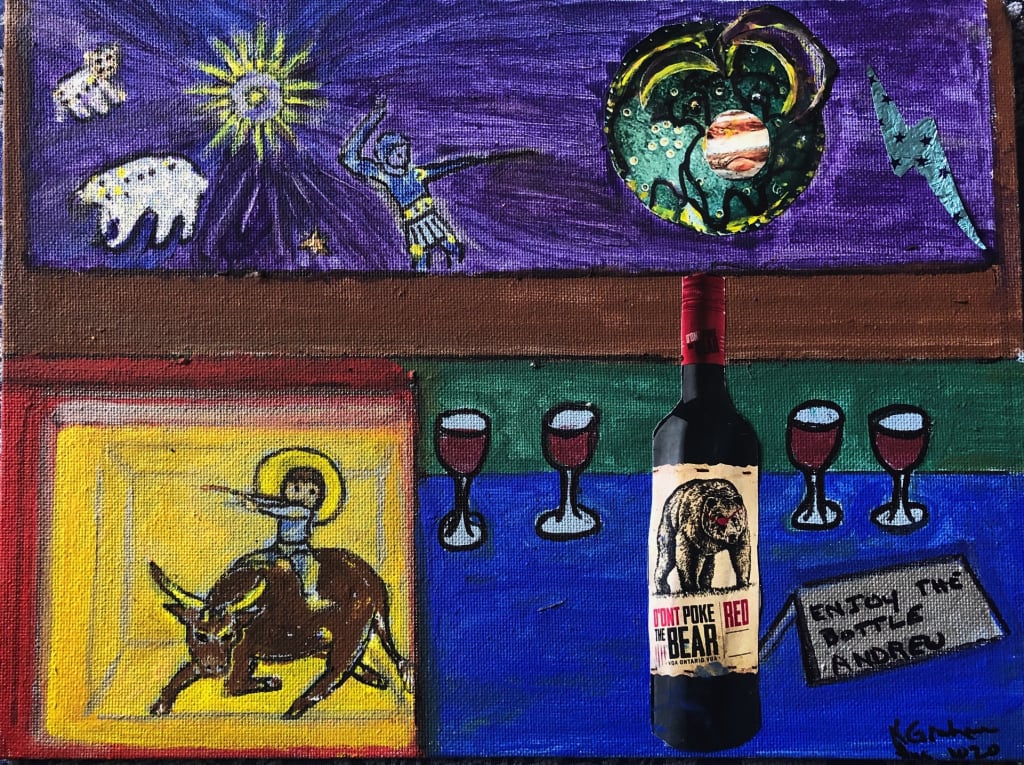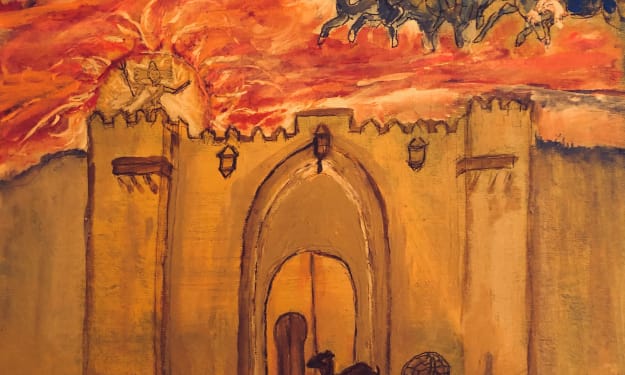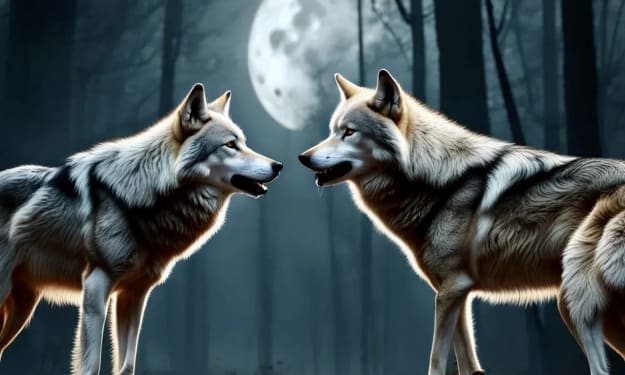
It was 2021, a pivotal time in the world. Travel restrictions had just been lifted. My three childhood friends coordinated a visit to our hometown. Philomena, the philosopher, Axel,the astronomer, Eddy, the economist and I, the writer, had worked to maintain our special bond with each other.
During high school, we had joined the Toastmasters club. We developed our strengths through public speaking and found an escape from dealing with the oppression and prejudice we faced growing up as immigrants and nerds.
Believing mental development never achieves completion, getting together for our annual ‘theme’ night was our way to reconnect. With notes in hand related to our fields of interest, we began an impromptu co-creation of a dialogue on this years topic.
I poured a bottle of “D’Ont poke the bear wine,’ explaining, “The company that produces this blend of cabernet and baco noir, donates a portion of its profits to anti- bullying causes. A fitting drink with which to approach this year’s topic. Cheers.”
Philomena lifted her glass. “Philosophically, bullying provokes either a defence against an uncomfortable truth or submissive silence. Thomas Aquinas, the ‘dumb ox’, said little, but with the strength of his great mind, defended logic and reason. He bellowed about faith in others and of the intellect that holds unknown powers. The Catholic church has issued greater and lesser papal bulls, to control its herd. Many bulls have revealed limited awareness, with fear-driven actions that have harmed others.”
Eddy piped up. “Economically, the pandemic has led to fear of the unknown, creating a raging Bull market. The strategy to ride the bucking beast involves the Greater Fool Theory. Overpayment for assets, by speculators, depends on a greater fool than oneself, who will overpay more. The trick is to get out before prices drop in a pessimistic bear market. The bull usually has its head down and raises its horns to fight. The bear is usually upright and lowers its head to fight.”
Axel spoke. “Bulls are important in astronomy. Palaeolithic cave paintings of the bull-shaped Aurochs Bos primigenius, represent the constellation Taurus. As I understand, since 4000 BC, Egyptians have worshipped the bull god Apis, born of fire at the equinox. Jupiter, orbits into the constellation Taurus almost every 12 years. The oval loop of the ankh is said to represent the Eye of Horus, located in the eye of Jupiter. An obelisk, the pillar of the Boatman, features the three horned bull, Tarvos Trigaranus, that honours Jupiter as it forms the ring through the bull’s nose and measures the cyclic, celestial movement of stars and planets, comets and meteor showers.”
“Jupiter,” Axel continued, "was the sacred winged bull known as Anu, the Great Bull of Uruk and supreme lord of the heavens and Marduk, the bull of Utu.Jupiter has a myriad of identities and is known also as Mnevis, Ptah, Baal, El, Bel, Nibiru, meaning crossing point or point of transition and the Islamic cosmic bull Kuyutha. Zeus, in bull form, mated with the mortal Semele. Titans ripped their son Zagreus to pieces, but for his heart, which Zeus put in his thigh. From there Dionysius, a twice born god with a bull face and horns, was resurrected only to be dismembered before his rebirth as a bee. Happily,” Axel added, “Dionysian mysteries include apiculture that provides honey used in wine and mead.”
I spoke. “This is the Year of the Metal Ox, which celebrates the reliably strong, opinionated and stubborn bull. Here’s a summary of the story of the Ten Bulls of Zen, that outlines the Chan Buddhist path of realizing one’s true nature.”
“A farmer looks for a bull and follows the footprints, then sees, captures and tames the bull with a whip and rope. He rides on the bull, playing his flute. At his home, they rest. No further training is needed. They understand each other. Then the soft, gentle and loving- natured bull disappears. The farmer returns to society, having acquired learned wisdom and compassion.”
The four of us raised our glasses. Axel began the second round.
“In astrological myth,” he said, “the Pleiades, found in the constellation Taurus the bull, are called the seven Ladies of the Universe. The consorts of the Bull-god Khnum, called the seven cows and the sisters of Hathor, were also part of Osiris’ celestial herd. They are the Krttikas, wet nurses of Rudra, the half male and female, son of Shiva, both who travelled on the bull Nandi. They were also called the Fairy cattle of the Celts, and named the 'little eyes' by the Tonga.”
“The Nebra disc from 1600 BC, depicts the Pleiades and cycles of the moon, planets and conjunctions within the winged Peacock bull Taurus. On December 24, Orion aligns with the dog star, Sirius, as the constellation Virgo rises in the East. Orion's sword points at Aldebaran, the Follower, and eye of Taurus.”
It was Philomena’s turn. “Now to blow my own horn. In the Icelandic Prose Edda, Gjallarhorn is the war horn that sounded a battle, held mead and possessed the power to reveal untold knowledge."
“Sun and moon gods were dual gendered and had horns. Sun gods partnered with moon gods that reflected their light. Their partnership resembles the Hebrew Merea, male and female advisors, confidential friends and guiding spirits of leaders.”
Eddy roused. ”Thanks. Merea reminds me of Mera, an acronym for Multi-scale Entanglement Renormalization Ansatz. An ansatz estimates the starting value of a solution to a problem or phenomenon, then offers a precise answer. In an ansatz, a small change has a big influence, in the eternal changing nature of algorithms.”
"Elephant bulls suffer from a musth, with elevated testosterone leading to aggression, greed and self-indulgence. Many political leaders often become full of bull and suffer the same condition."
“Like the markets, bulls are colour-blind. Bulls generally move slowly, but when goaded, by movement of a red flag that the matador waves, or provoked and taunted by being shocked, hit, or terrorized as a reaction to a rope tied around their testicles, will utilize their strength.
As a vegetarian, I will not cut the bull. The brutal, savage depravity against the voiceless, slaughtered, sacrificial innocents, for amusement, is beyond my moral limits.”
I continued. “In hieroglyphics, the bull represents the Ka or soul that survives after death. It is resurrected each year. The Sanskrit term ‘kalpa’ or ‘kappa’ describes Dharma, domestic and sacrificial rituals of bulls, from which the Os sacrum, or resurrection bone, is removed from extremities of the spine. In Kalpa Yoga, the coccyx is the energy centre. The Holy bone acts as fulcrum. It looks like angel wings. It is said to transport the fire energy of spirits, shamans and deities through portals between worlds.”
“Great cyclic periods are called ‘kappa’. Kappa is based on the tenth letter of the Greek alphabet Q that comes from ‘Koppa’, written with a lightning symbol.” I moved my finger to show them (ϟ).
I continued, “This symbol is associated with Jupiter, the sky god. Q designates the Quelle gospel of the Apostle of Scientists, doubting Thomas, who demanded evidence of the resurrection. Thomas wrote a source document, that other apostles used. He prefaced the secret words of wisdom with the phrase, ‘and Jesus said’.”
“The Japanese call the river imp deity ‘kappa’. Many legendary leaders were born of mythical sea-beasts. Charlemagne, the charismatic, divine descendent of Merovee, the first of the Merovingian Frank dynasty from 400 BC, had two fathers, King Clodion and the mythical, amphibious five-horned Quinotaur. The beast combined myths of the minotaur, and Poseidon with his trident, and dragons or a seahorse that looks like the hippocampus, the Cornu Ammonis, Ammon's horn."
"The hippocampus stores memories from experience and intuition, then creates signalling pathways that make the skeleton in the closet twitch with life. Stories of fish-tailed Bull kings are found from Mesopotamian myths of Oannes. 'Journey to the West', written in 16AD, merged Chinese and Buddhist texts in the self-proclaimed bull-fish, a Great sage who pacifies Heaven.”
The final round began. I called on my feminist nature and education. “Matriarchal societies developed agriculture. Both men and women were priests, servants, and warriors. There was progression of female warrior queens who ruled the Ptolemaic dynasty, including Neithikret between 2148-44 BC, Sobeknefru between 1787-1783, Hapshepsut between 1473-1498, Nefertiti and Cleopatra in 1336 and 30 BC respectively.”
“Sometime around 1200BC, the Hittites replaced the revered primordial Great Earth mother, with sky daddies, who dominated by patriarchal reason. Feminine feasts became masculine based festivals. The Sanskrit described noble young warriors as Maryaka", meaning “little bull amidst the cows’, translating Maryaka as male, instead of person.”
"The first written epic,” I concluded, “describes the adventures of Gilgamesh and Enkidu. It recognizes feminine power, demonizing the feminine who tames Enkidu from his wild state. In her fury, Inanna, scorned in love by Gilgamesh, sends the great Bull of Heaven to lock horns with them. Enkidu is killed after literally grabbing the bull by the horns, even though he repented his actions against her. At Enkidu’s death, Gilgamesh offers honey, believed to protect the spirit as it soars to the afterlife, in a carnelian bowl, symbolizing the heart, considered the seat of life. Gilgamesh then wanders, stricken with the grief of mortality. A woman’s advice to enjoy life in happiness makes him forget about Enkidu."
Philomena spoke, “In Virgil’s Georgics, a shepherd lost his bees. He needed to rip the flesh of an ox so bees could spontaneously generate. Ovid, his contemporary, described the Bugonia, the birth of a swarm of bees that appeared after the death of a bull. A century later, Nicander wrote the story of Eurydice’s death. Her nymphs killed all of Aristaeus’ bees so he sacrificed bulls and heifers who later, miraculously, gave rise to bees.”
Axel spoke. “According to Antigonus, a 3rd century writer, bee and bull stories originated in Egypt. At the spring equinox, the Pleiades, said to resemble a clusters of bees born of Taurus, move to the constellation Apes, Latin for Bee. Bees are said to arrive and honey gathered between the rise and setting of the Pleiades"
“Europa, known as Metis, Juno and Minerva, the goddess of intelligence, intuition and wisdom, transformed to bee inside of Jupiter’s body then emerged from his head, as the Potnia Theron, Queen mother of the wild bees and Mistress of the animals. She is associated with life-death and rebirth.”
"The Melissa were bee maidens of Artemis, the guardian of wild bees. Their honey nurtured many gods at birth and after their death, while their souls awaited reincarnation. Bees, beehives and honey were sacred, and associated with death."
"On the eve of Beltane, May 1, Aldebaran, the eye of Taurus, is low in the sky. Fires are set, beekeepers move their hives and cattle are slaughtered in preparation for the winter. Sanctuaries to Odin known as the god Irmin, and the German Bee god Imme, used stone and wood Irminsuls to rest the bulls head upon, before slaughter, after which bees were thought to emerge.”
Eddy remarked. “May 1 is European International Workers Day, celebrating the right to a shorter work day. April 31 is the Witches’ night, when evil plans are made with the horned god turned devil. Ironically, that’s when Canadian taxes are due."
"In conclusion. We are a sleuth of bears. We have successfully examined what some might consider cock and bull stories to understand bullying. We have identified the nature of a bull and respect what provokes a bull. For the record, bears can tame a raging bull, so don't poke the bear."
"Now raise your glasses. Here's to managing another get-together. Let's spend the rest of the evening catching up on friendships as constant as Polaris in the Little Bear. Give each other warm bear hugs when we go our separate ways, a little wiser."
We laughed and did just that.
About the Creator
Katherine D. Graham
My stories are intended to teach facts, supported by science as we know it. Science often reflects myths. Both can help survival in an ever-changing world.
Enjoyed the story? Support the Creator.
Subscribe for free to receive all their stories in your feed. You could also pledge your support or give them a one-off tip, letting them know you appreciate their work.






Comments
There are no comments for this story
Be the first to respond and start the conversation.